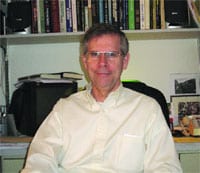Clearing the Block Eye-movement Technique Helps Patients Overcome Psychological Traumas
Dr. George Abbott told the story of a child who was riding a bicycle on a rail line and got stuck on the track.
As a train approached, the engineer saw him too late and couldn’t slow down. The boy, with his back turned, focused on extricating the bike, never saw the engine, and was struck and killed.
“The engineer felt terrible guilt and remorse,” said Abbott, a clinical and counseling psychologist at Holyoke Medical Center. “He couldn’t sleep. He said, ‘if only I had pulled the whistle — maybe the child would have looked up. Maybe he would have seen, and left his bike and gotten off the track.’”
The engineer was recalling all this as he began a behavioral-health technique known as eye-movement desensitization and reprocessing (EMDR), which helps victims of post-traumatic stress disorder (PTSD) and other types of psychological trauma to overcome the mental burden of disturbing events.
“As he started to recall more detail about the event, he started to think more clearly about what had happened,” Abbott said. “Then, in the midst of the process, he realized, ‘I did pull the whistle.’ He had done it instinctively, but at the time, he was more aware of the horror of what was occurring. He did get relief from that; it’s still a terrible thing that happened, but now he can look at it and say, ‘I didn’t cause this.’ And knowing that, he can rest.”
The EMDR technique, which has been in existence only about 20 years, involves helping patients achieve what’s known as ‘dual-attention awareness,’ which requires them to mentally focus on the trauma while the therapist guides their eyes back and forth.
“To set up dual attention, you have a person think about different aspects of the disturbing experience,” Abbott explained. “Meanwhile, they’re doing a series of lateral eye movements. The person’s awareness is situated midway between what they’re thinking about this disturbing experience and this external activity they’re doing. They have one foot in the past and one foot in the present.”
When they’re positioned between these two poles, he told The Healthcare News, the information begins to be digested, and the person is able to let go of the disturbance and allow the related pain, anxiety, depression, anger, and frustration to fall away, to be replaced by a new understanding about the traumatic memory.
“Sometimes people notice new feelings and new facts about a situation,” he said. “They get new insights and thoughts that advance their understanding of what has happened, and they learn from it.”
Mind Matters
Abbott explained that the brain is constantly processing experiences and emotions, but traumatic events have a way of lodging themselves in one’s psyche so that the brain cannot process them correctly. That can lead to problems adapting to everyday situations.
“The brain is wired such that a person is able to adapt to their present life whatever feelings this day brings to them,” he said. “The nervous system is there to help you figure out what’s going on in your environment today and deal with it, drawing on all the learning you’ve done up to now.”
In other words, he continued, “when the brain pieces together all this information, it tends to sort out the negative, painful stuff and keep the other stuff and learn from the situation. But if a disturbing event jams up the process, you’re filled with negative feelings and expectations, negative views of yourself, and nothing is learned.”
Abbott offered, as an example, a child who burns his hand on a stove.
“It scares him. He’s terrified and crying in pain. But it’s not an overwhelming situation, and the brain processes that information quite nicely,” he said. “He’ll get some hugs from his mother, maybe some ice, and a month later, you can ask him about the event, and he’s pretty much forgotten all the pain.
“He hasn’t forgotten that there was pain,” he continued, “but he’s not feeling that pain, or the emotions of fear and horror. They’re going to be done, and what’s left is learning: he’s going to say, ‘don’t put your hand on the stove.’ That’s the way the nervous system works; it takes in experiences, processes them, tosses out what’s not needed for future adaptation, and retains what is needed.”
Now, Abbott continued, consider another child whose house burns down after he played with a candle in an upstairs room, and someone has died in the fire.
“That experience is going to be too overwhelming, and he’s not going to be able to process that,” he explained. “That’s going to sit there as a big block in his mind, inhibiting and interfering with his development. He might always be afraid of going on the second floor of a building. Or at Christmas, when he sees lighted candles in the windows, or a Christmas tree set up near a radiator, he might become extremely anxious and even have panic attacks. He might have difficulty sleeping at night when he’s around those things.”
A victim of an auto accident might suffer similar problems adapting to everyday activities, Abbott continued.
“He may have trouble getting behind the wheel again, or being in the back seat, or driving across a certain highway, or in driving in inclement weather,” he said. “That can prohibit someone from doing what they need to, such as going to work or visiting their family.”
EMDR is one way to break that crippling cycle, he said. “We’re able to take that old experience and give the person’s brain another crack at processing it and removing it, tossing out the negative stuff and incorporating some new learning that can help them.”
New Technique
EMDR first showed up in medical literature in 1989, and the early 1990s saw a flurry of studies of the practice, Abbott explained. “By 1997, it had been established, through controlled-outcome research, to be a valid form of therapy for post-traumatic stress disorder.”
By the turn of the century, it had been approved as a first-line treatment for PTSD by the Department of Defense, the Department of Veterans Affairs, the American Psychiatric Assoc., the National Institute for Clinical Excellence, the International Society for the Study of Traumatic Stress, the governments of Israel and Great Britain, and other bodies. In this region alone — Western Mass., Southern Vt., and Northern Conn. — about 300 practitioners are trained in the technique.
“We actually use it for things beyond post-traumatic stress disorder, although it hasn’t been researched for other problems,” Abbott noted, citing its use to help people recover from divorce, long-term domestic abuse, and other psychologically damaging issues that don’t fall under the umbrella of PTSD, which typically stems from a one-time traumatic event.
“There’s a difference between traumatic and traumatizing events,” he explained. “If you’ve gotten divorced and you can’t get over it, it does not qualify as PTSD, even if the person is very disturbed by it. Someone might be really distraught a year later because their spouse rejected them, and that’s the worst thing that has happened to them in life, but that’s not a traumatic event, even though, for many people, it is a traumatizing event.”
Whether used to clear the psychological block of PTSD or a traumatizing experience like divorce, Abbott said research indicates that EMDR is successful between 90{06cf2b9696b159f874511d23dbc893eb1ac83014175ed30550cfff22781411e5} and 95{06cf2b9696b159f874511d23dbc893eb1ac83014175ed30550cfff22781411e5} of the time, and is especially effective on children.
However, the technique can be somewhat trickier for an adult dealing with a childhood trauma. The reason in such cases may be that the trauma occurred when the brain was still wiring itself, and became more intertwined in the brain’s development.
The technique is not used for biologically based conditions like depression, bipolar disorder, and schizophrenia, but only for what Abbott called experience-based pathologies. Still, for these psychological traumas, “this is a very potent tool.”
And one that has helped countless people — from soldiers to engineers — get their lives … well, back on track.


